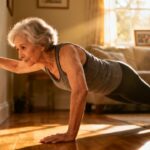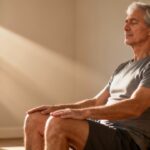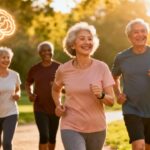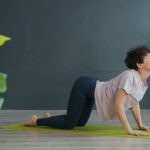Walk through any neighborhood in Japan and you’ll witness something remarkable – elders in their 80s and 90s moving with confidence, climbing stairs without assistance, and maintaining perfect posture. Meanwhile, in the US, nearly half of adults over 75 rely on mobility aids just to navigate their own homes.
The difference isn’t genetics or miracle diets. It’s five simple daily habits woven into Japanese culture that keep joints young, muscles strong, and balance sharp. These aren’t strenuous workouts or complicated exercises – they’re lifestyle rituals that anyone can adopt.
The 15-Minute Morning Neurological Reset
Most people accept morning stiffness as inevitable aging. You wake up, joints feel tight, energy isn’t quite there. But here’s the truth – that stiffness doesn’t fade, it compounds. Every morning you skip meaningful movement, your nervous system stays sluggish and joint fluid remains thick.
Japanese elders practice something called radio taiso – a full body neurological reset practiced by millions every morning. This isn’t exercise or yoga, but a gentle reactivation of every major joint stabilizer muscle and balance circuit within 15 minutes of waking up.
Research from Tokyo Metropolitan University shows those who practice daily morning joint movement report 37% less joint stiffness throughout the day, even into their 80s and 90s. The best part? You can do a simplified version in your pajamas right in your living room and feel your body shift from stiff and foggy to fluid and alert in under 5 minutes.
The Floor Transition: Your Hidden Strength Test
Let me ask you something uncomfortable: If you fell right now, could you get up without help? Most Americans over 65 can’t – not because they’re weak, but because modern life has erased the single most important daily movement for lifelong strength: getting up from the floor.
In Japan, floor transitions are part of daily life through low tables, futons, floor seating, and tea ceremonies. This movement trains your fall recovery reflex better than any exercise machine ever could. When you rise from the floor, your brain activates a deep neurological sequence – glutes, quads, core, hip flexors, and ankle stabilizers firing in specific order.
A 2012 Brazilian study found that people who could rise from the floor without using their hands had an 83% lower mortality rate over 6 years. This ability isn’t just a strength marker – it’s a predictor of independence, survival, and dignity.
The Japanese Walking Secret That Protects Your Joints
We’ve been told for decades to just walk more, but how you walk matters far more than how far you walk. In the US, most people walk with long strides, heavy heel strikes, and forward-leaning posture – quietly destroying joints with every step.
Researchers at Stanford found that typical heel striking generates two to three times your body weight in impact with every step. Multiply that by 8,000 steps daily, and you’re sending shock waves through your ankles, knees, hips, and lower back.
Japanese elders walk differently – shorter, softer steps with midfoot landing instead of heel striking. Their posture stays tall with gently engaged core. Biomechanical studies show this style reduces joint impact by 32% and activates 47% more stabilizer muscles. This isn’t just joint protection – it’s full body balance insurance built into every step.
Hip Mobility by Design: The Joint That Keeps You Independent
You can lose 40% of your hip mobility and never notice until it’s too late. The hip joint is meant to move in multiple directions, but western lifestyle locks it at 90 degrees almost all day long – sitting at breakfast, driving, watching TV.
In Japan, hip mobility is baked into daily life through environment. Floor sitting opens hips in external rotation, the seiza position promotes deep knee and ankle flexion, and sleeping on futons requires deep squat transitions twice daily.
Full hip mobility doesn’t just protect your hips – it safeguards your knees, spine, and balance. A study from the Japanese Orthopedic Association found that elders who retain full hip mobility had an 89% lower chance of needing a walker after age 80.
Environmental Balance Challenge: Training Your Brain Daily
In America, balance training happens at physical therapy after you’ve already fallen. In Japan, balance is trained before you ever know you need it – through how they live.
Traditional Japanese homes feature a genkan – a raised entryway that forces you to step up and down while removing shoes. Every time you step up, balance on one foot, twist, and reach for slippers, you’re running a full body proprioceptive drill without realizing it.
Modern western life is engineered for predictability – flat sidewalks, even flooring, bright lighting, handrails everywhere. While this feels safer, it’s robbing your body of the very challenges it needs to stay sharp.
A Kyoto University study showed that elders who regularly navigated varied terrain had a 43% better balance recovery reflex when stumbling. Balance isn’t lost with age – it’s lost with comfort.
How to Start Your Mobility Journey
If these habits feel inspiring but overwhelming, start small with what your body needs most:
- If you wake up stiff or sluggish, begin with the morning movement ritual
- If getting off the floor feels impossible, focus on floor transition strength
- If walking hurts your knees, shift attention to your gait mechanics
- If your back or knees ache, chances are your hips are locked – start there
- If you’ve noticed wobbly balance, the environmental challenge habit is your key
You don’t need all five habits to make progress. Just pick one, stay consistent for 14 days and observe. Mobility isn’t about doing more – it’s about doing what matters.
Growing older doesn’t mean growing weaker. It means getting wiser about what your body truly needs to stay free, strong, and independent. The Japanese don’t age better because of perfect genes – they age better because they never stopped moving with intention.
You don’t need to overhaul your life. You just need to change the way you live – the small moments, the transitions, the steps, the morning minutes. Pick one habit, practice it daily for two weeks, and watch what shifts not just in your body but in your belief about aging.
Your body is still listening, and movement is still the language it understands best.








